Enhancement of Light Efficiency of Deep-Ultraviolet Light-Emitting Diodes by Encapsulation with a 3D Photonic Crystal Reflecting Layer
Abstract
1. Introduction
2. Materials and Methods
2.1. Experimental Materials
2.2. UVC LED Lead Frame with 3D PhC Reflector
2.3. Characterizations
3. Results
3.1. The 3D PhC Nanostructures on the UVC LED Lead Frame
3.2. The 3D PhC Reflective Layer Analyses
3.3. Optical Properties of UVC LEDs with 3D PhC Reflective Layer
4. Conclusions
Supplementary Materials
Author Contributions
Funding
Data Availability Statement
Acknowledgments
Conflicts of Interest
References
- Nicolau, T.; Filho, N.G.; Padrao, J.; Zille, A. A Comprehensive Analysis of the UVC LEDs’ Applications and Decontamination Capability. Materials 2022, 15, 2854. [Google Scholar] [CrossRef]
- Hsu, T.-C.; Teng, Y.-T.; Yeh, Y.-W.; Fan, X.; Chu, K.-H.; Lin, S.-H.; Yeh, K.-K.; Lee, P.-T.; Lin, Y.; Chen, Z.; et al. Perspectives on UVC LED: Its Progress and Application. Photonics 2021, 8, 196. [Google Scholar] [CrossRef]
- Kebbi, Y.; Muhammad, A.I.; Sant’Ana, A.S.; Prado-Silva, L.d.; Liu, D.; Ding, T. Recent advances on the application of UV-LED technology for microbial inactivation: Progress and mechanism. Compr. Rev. Food Sci. Food Saf. 2020, 19, 3501–3527. [Google Scholar] [CrossRef]
- Matafonova, G.; Batoev, V. Recent advances in application of UV light-emitting diodes for degrading organic pollutants in water through advanced oxidation processes: A review. Water Res. 2018, 132, 177–189. [Google Scholar] [CrossRef] [PubMed]
- Loveless, J.; Kirste, R.; Moody, B.; Reddy, P.; Rathkanthiwar, S.; Almeter, J.; Collazo, R.; Sitar, Z. Performance and reliability of state-of-the-art commercial UVC light emitting diodes. Solid-State Electron. 2023, 209, 108775. [Google Scholar] [CrossRef]
- Zhu, Y.; Lu, H.; Wang, J.; Yu, T.; Li, Z.; Tian, Y. The dependence of light extraction improvement on optimized surface microstructure for AlGaN-based UVC-LEDs considering TM-polarized emission. Micro Nanostruct. 2023, 181, 207614. [Google Scholar] [CrossRef]
- Chen, K.-T.; Wang, C.-J.; Ke, Y.; Kao, Y.-C.; Chen, H.; Lin, Y.S.; Han, J.; Lin, C.F. Ultraviolet-C AlGaN Resonant-Cavity Light-Emitting Diodes with Thermal Stability Pipe-AlGaN-Distributed Bragg Reflectors. ACS Omega 2023, 8, 3478–3483. [Google Scholar] [CrossRef]
- Wu, S.; Guttmann, M.; Lobo-Ploch, N.; Gindele, F.; Susilo, N.; Knauer, A.; Kolbe, T.; Raß, J.; Hagedorn, S.; Cho, H.K.; et al. Enhanced light extraction efficiency of UV LEDs by encapsulation with UV-transparent silicone resin. Semicond. Sci. Technol. 2022, 37, 065019. [Google Scholar] [CrossRef]
- Yeh, C.-H.; You, H.-S.; Chang, Y.-C.; Kuan, C.-Y.; Wu, H.-T.; Hsu, W.-D.; Shih, C.-F. Design of high-entropy films as ultra-violet light reflector. Appl. Mater. Today 2024, 36, 102013. [Google Scholar] [CrossRef]
- Wan, C.; Zeng, Z.; Xiao, G.; Lan, Y.; Li, C.; Lin, H.; Wang, H. Efficiency Improvement of UVC LEDs by Epoxy Molding Compound With Metallized Reflector. IEEE Photonics Technol. Lett. 2023, 35, 1387–1390. [Google Scholar] [CrossRef]
- Aguirre, C.I.; Reguera, E.; Stein, A. Tunable Colors in Opals and Inverse Opal Photonic Crystals. Adv. Funct. Mater. 2010, 20, 2565–2578. [Google Scholar] [CrossRef]
- Li, Y.; Duan, G.; Liu, G.; Cai, W. Physical processes-aided periodic micro/nanostructured arrays by colloidal template technique: Fabrication and applications. Chem. Soc. Rev. 2013, 42, 3614–3627. [Google Scholar] [CrossRef] [PubMed]
- Tran, G.T.H.; Koike, M.; Uchikoshi, T.; Fudouzi, H. Rapid Growth of Colloidal Crystal Films from the Concentrated Aqueous Ethanol Suspension. Langmuir 2020, 36, 10683–10689. [Google Scholar] [CrossRef] [PubMed]
- Lai, C.-F.; Lee, Y.-C.; Tsai, T.-L. Candlelight LEDs fabricated by using composite silica photonic crystals. Opt. Mater. Express 2015, 5, 307–313. [Google Scholar] [CrossRef]
- Lai, C.-F.; Li, J.-S. Self-assembly of colloidal Poly (St-MMA-AA) core/shell photonic crystals with tunable structural colors of the full visible spectrum. Opt. Mater. 2019, 88, 128–133. [Google Scholar] [CrossRef]
- Jing, D.; Gao, J.N.; Tang, F.Q. Fabrication of colloidal crystal array by self-assembly methods. Prog. Chem. 2004, 16, 321–326. [Google Scholar]
- Kim, M.; Kim, J.B.; Kim, S.-H. Hyperreflective photonic crystals created by shearing colloidal dispersions at ultrahigh volume fraction. Microsyst. Nanoeng. 2024, 10, 21. [Google Scholar] [CrossRef]
- Liu, G.; Zhou, L.; Wang, C.; Wu, Y.; Li, Y.; Fan, Q.; Shao, J. Study on the high hydrophobicity and its possible mechanism of textile fabric with structural colors of three-dimensional poly(styrene-methacrylic acid) photonic crystals. RSC Adv. 2015, 5, 62855–62863. [Google Scholar] [CrossRef]
- He, X.; Yu, B.; Zhang, X.; Cong, H. pH-sensitive colloidal crystals built from monodisperse poly(St-MMA-SPMAP-AA) microspheres via air-liquid interface assembly. Opt. Mater. 2023, 135, 113350. [Google Scholar] [CrossRef]
- Zhou, Q.; Dong, P.; Cheng, B.Y. Self-assembly under gravity sedimentation of large size silica particles. Acta Phys. Sin. 2004, 53, 3984–3989. [Google Scholar] [CrossRef]
- Yang, L.; Gao, K.; Luo, Y.; Luo, J.; Li, D.; Meng, Q. In Situ Observation and Measurement of Evaporation-Induced Self-Assembly under Controlled Pressure and Temperature. Langmuir 2011, 27, 1700–1706. [Google Scholar] [CrossRef] [PubMed]
- Dumanli, A.G.; Savin, T. Recent advances in the biomimicry of structural colours. Chem. Soc. Rev. 2016, 45, 6698–6724. [Google Scholar] [CrossRef] [PubMed]
- Lai, C.F.; Chang, C.C.; Wang, M.J.; Wu, M.K. CCT- and CRI-tuning of white light-emitting diodes using three-dimensional non-close-packed colloidal photonic crystals with photonic stop-bands. Opt. Express 2013, 21, A687. [Google Scholar] [CrossRef] [PubMed]
- Chen, J.; Liu, J.; Huang, Y.; Liu, R.; Dai, Y.; Tang, L.; Chen, Z.; Sun, X.; Liu, C.; Zhang, S.; et al. Hillock Related Degradation Mechanism for AlGaN-Based UVC LEDs. Nanomaterials 2023, 13, 1562. [Google Scholar] [CrossRef]
- Shen, C.-H.; Yang, R.-L.; Gong, H.-L.; Zhu, L.-H.; Gao, Y.-L.; Chen, G.-L.; Chen, Z.; Lu, Y.-J. Optical power degradation mechanisms in 271 nm AlGaN-based deep ultraviolet light-emitting diodes. Opt. Express 2023, 31, 20265–20273. [Google Scholar] [CrossRef]
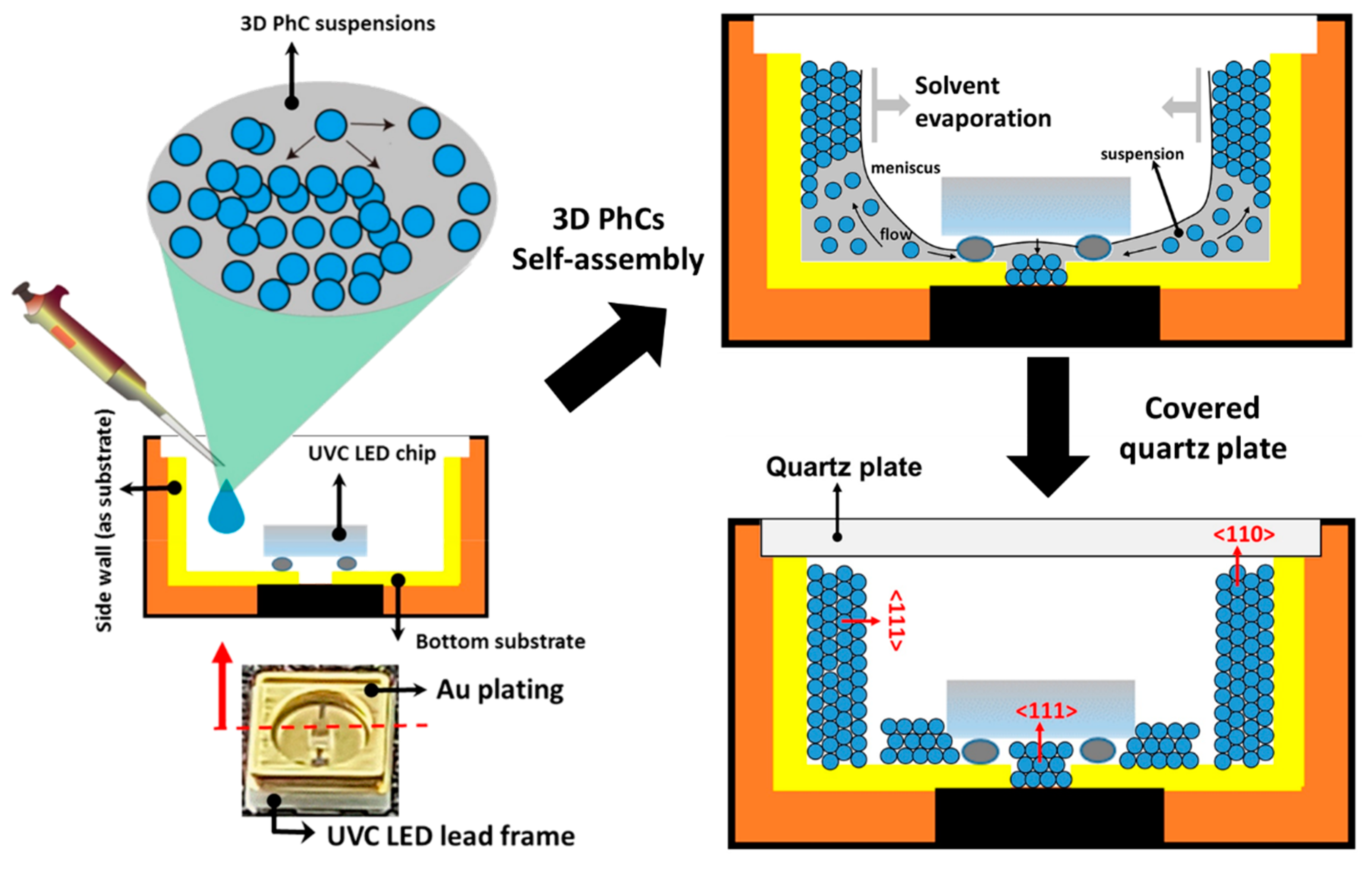
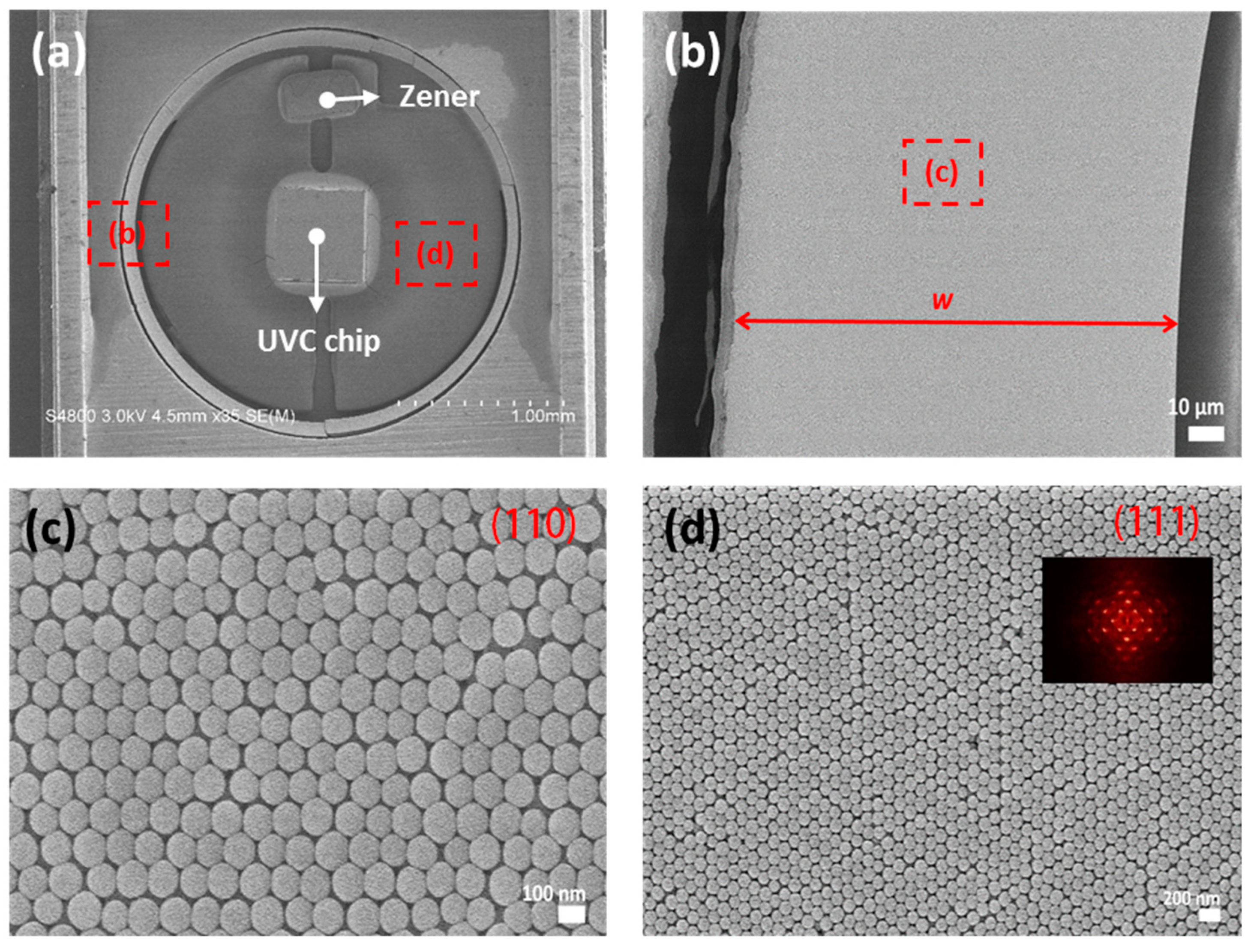
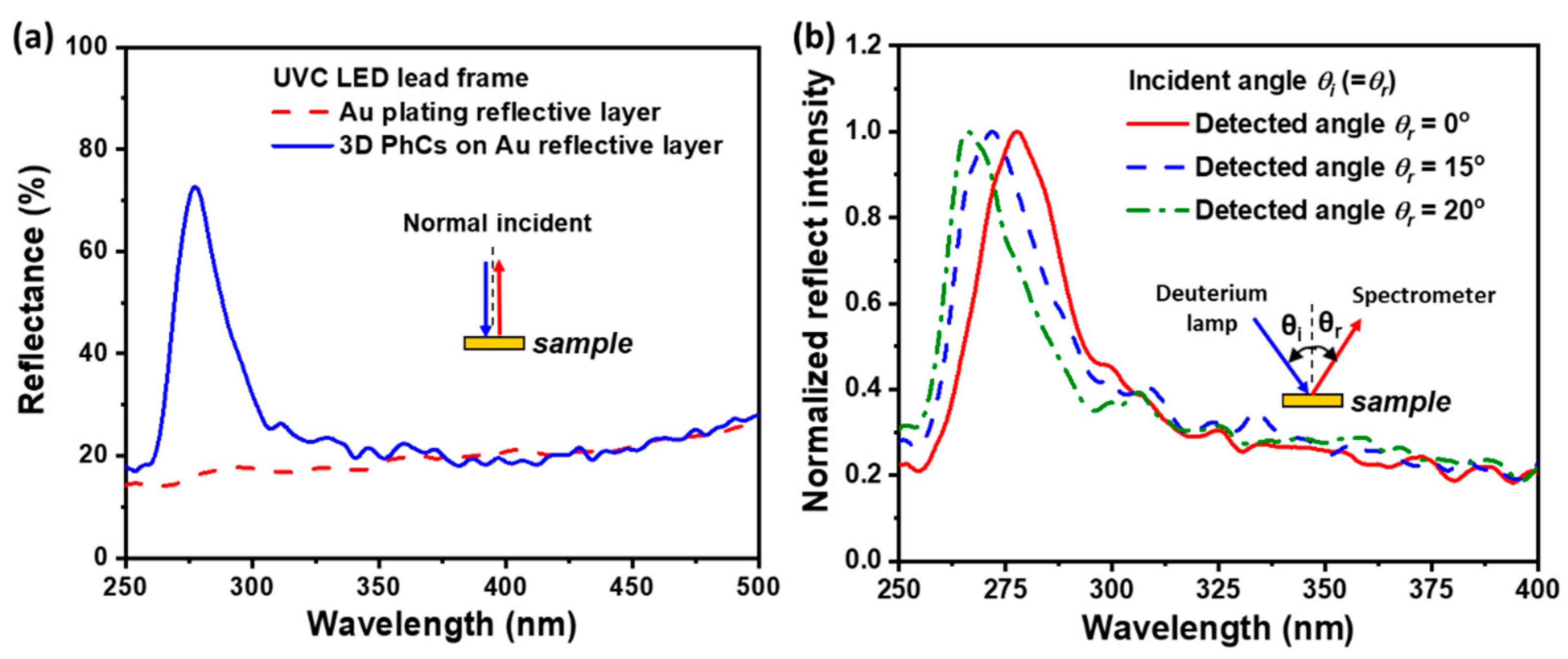
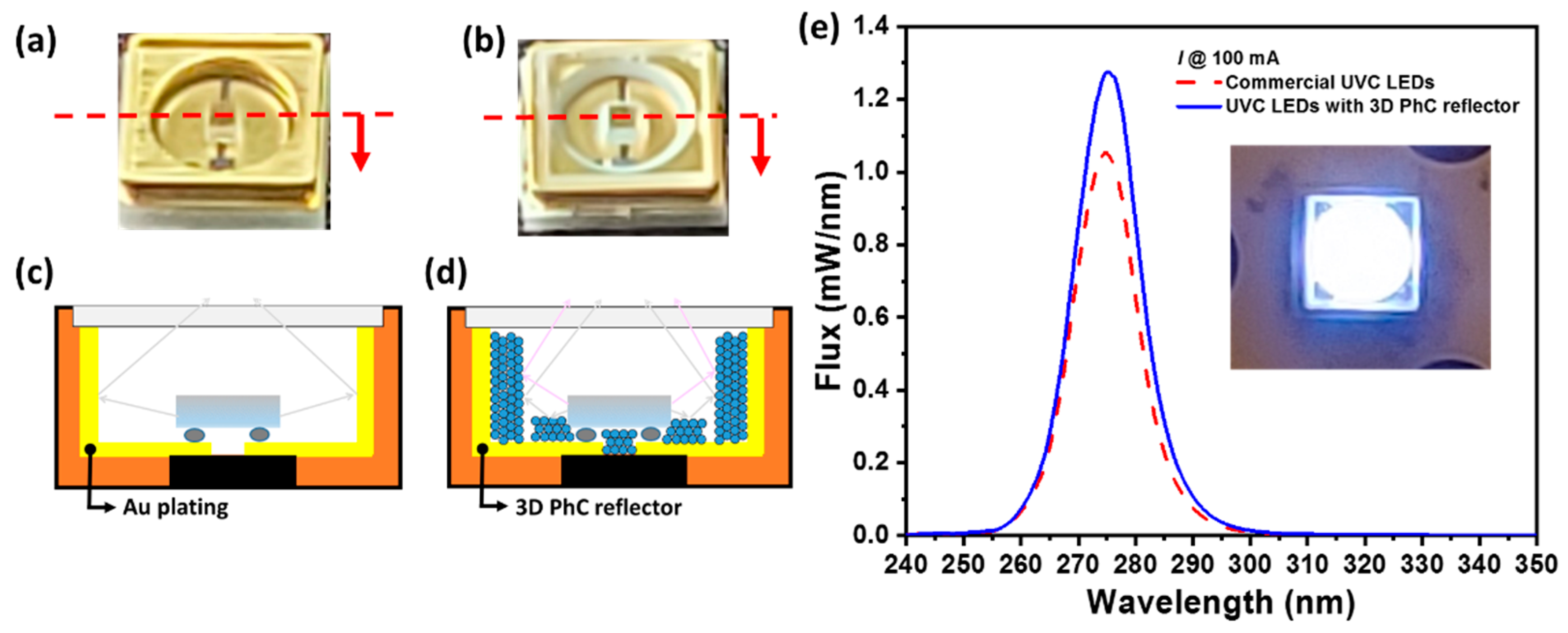
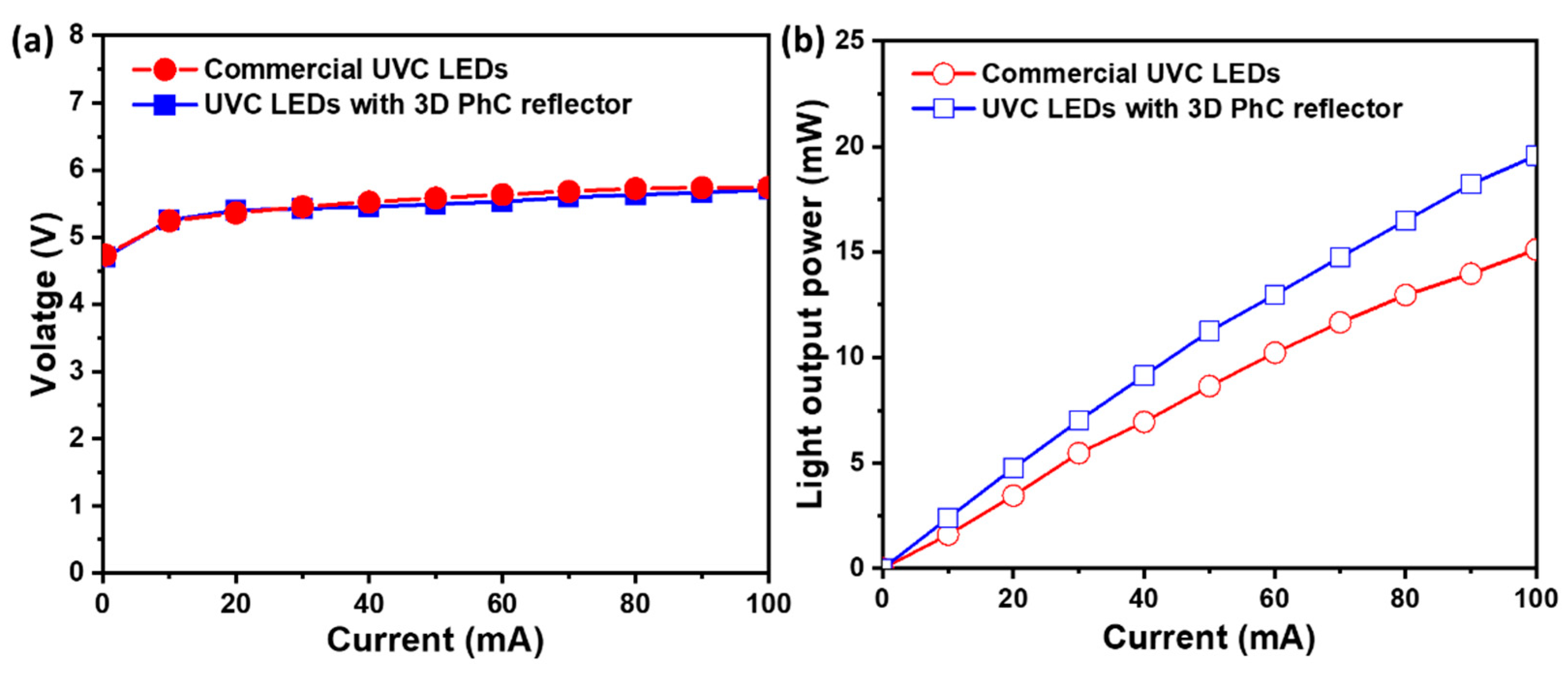
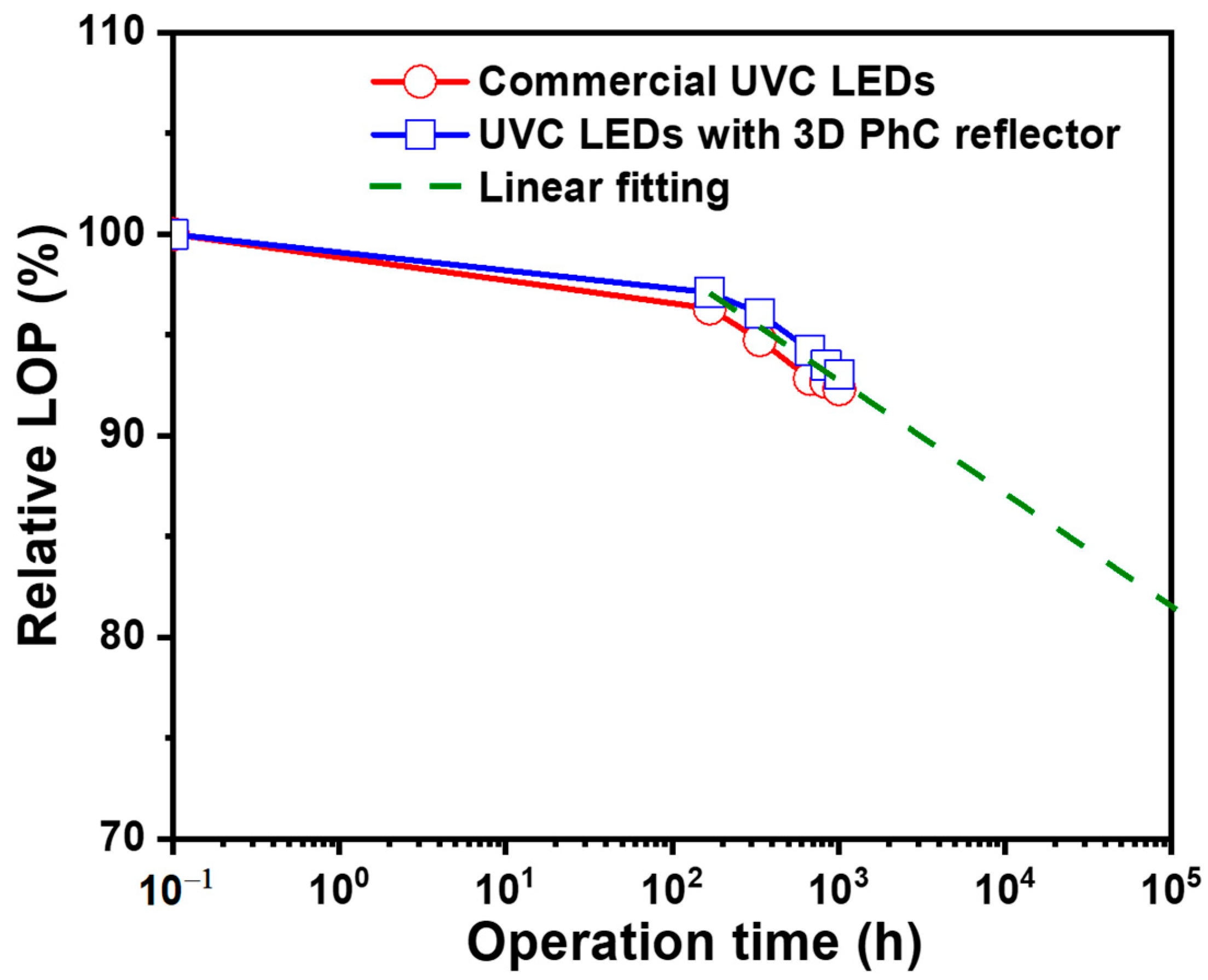
Disclaimer/Publisher’s Note: The statements, opinions and data contained in all publications are solely those of the individual author(s) and contributor(s) and not of MDPI and/or the editor(s). MDPI and/or the editor(s) disclaim responsibility for any injury to people or property resulting from any ideas, methods, instructions or products referred to in the content. |
© 2024 by the authors. Licensee MDPI, Basel, Switzerland. This article is an open access article distributed under the terms and conditions of the Creative Commons Attribution (CC BY) license (https://creativecommons.org/licenses/by/4.0/).
Share and Cite
Lai, C.-F.; Lin, C.-P.; Lee, Y.-C. Enhancement of Light Efficiency of Deep-Ultraviolet Light-Emitting Diodes by Encapsulation with a 3D Photonic Crystal Reflecting Layer. Nanomaterials 2024, 14, 983. https://doi.org/10.3390/nano14110983
Lai C-F, Lin C-P, Lee Y-C. Enhancement of Light Efficiency of Deep-Ultraviolet Light-Emitting Diodes by Encapsulation with a 3D Photonic Crystal Reflecting Layer. Nanomaterials. 2024; 14(11):983. https://doi.org/10.3390/nano14110983
Chicago/Turabian StyleLai, Chun-Feng, Chun-Peng Lin, and Yu-Chun Lee. 2024. "Enhancement of Light Efficiency of Deep-Ultraviolet Light-Emitting Diodes by Encapsulation with a 3D Photonic Crystal Reflecting Layer" Nanomaterials 14, no. 11: 983. https://doi.org/10.3390/nano14110983
APA StyleLai, C.-F., Lin, C.-P., & Lee, Y.-C. (2024). Enhancement of Light Efficiency of Deep-Ultraviolet Light-Emitting Diodes by Encapsulation with a 3D Photonic Crystal Reflecting Layer. Nanomaterials, 14(11), 983. https://doi.org/10.3390/nano14110983






